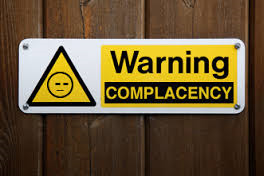Category Archives: Leadership
Introduction to Leadership Growth Hacks
Three Reasons You Don’t Want Content Employees
 “We must not be content to memorize the beautiful formulas of our illustrious predecessors. Let us go out and study beautiful nature.” —Paul Cezanne
“We must not be content to memorize the beautiful formulas of our illustrious predecessors. Let us go out and study beautiful nature.” —Paul Cezanne
Some think that contentment is the key to happiness but, it can be the enemy of progress. Employees are happiest when they are making progress, being challenged, and growing personally and professionally. Why be content, settling for the status quo, when you can be exploring, learning, and growing? Here are three reasons you don’t want content employees.
Passion
Contentment slowly suffocates the flame of passion. Passionate employees are excited to contribute and they thrive on being part of something bigger than themselves. Passion cannot be taught, it cannot be passed on from one person to another. Passion must stem from a belief in something that is of personal value. Help your employees understand the big picture goals of the organization and then acknowledge the value that their personal contributions bring to the table.
Drive
Drive is the desire to make progress, to go further than we have gone before, and achieve great goals. When employees become content, they tend to lose their drive. Encourage employees to never be content with the status quo. Nourish their desire to contribute to the forward progress of the organization. And, give them the credit they deserve for progress made.
Opportunity
Everyone wants the opportunity to take on challenges, learn new things, and grow. When employees become content they lose the ambition to put forth the extra effort needed to seize opportunity. Offer employees challenges that keep their work exciting. Give them access to the resources they need to meet these challenges head-on. Invest your time and energy into helping employees become the best they can be and then reward them for their growth.
Ignite the Fire
If your employees have become content their spark has burned out. Fuel their passion. Feed their drive. And, encourage them to pursue opportunities. Acknowledge the value that they add to the organization and reward progress and growth. It’s time to ignite the fire.
© 2016 Elizabeth Stincelli
Liz Stincelli is passionate about recognizing and inspiring the leader in each of us. She is the Founder of Stincelli Advisors where she focuses on helping organizations change attitudes, change communication dynamics, improve collaboration and problem-solving, engage employees, and strengthen organizational culture. Liz holds a Doctor of Management degree with an emphasis on organizational leadership.
Learn more about Liz by visiting her website, stincelliadvisors.com and connect with her on Twitter @infinitestin, Google+, and LinkedIn. You can contact her by email at stincelliadvisors@gmail.com.
Are You in the Habit of Management by Crisis or Crisis Management?
 “We’ve got to be judged by how we do in times of crisis.” —Johnnie Cochran
“We’ve got to be judged by how we do in times of crisis.” —Johnnie Cochran
Putting Out Fires
Johnnie Cochran’s quote suggests that it is during times of crisis that we really show what we are made of. I kind of disagree. While every one of us will be faced with crises, getting in the habit of putting out fires all day long says more about your management style than it does your character. This is what I would term as management by crisis. No time to think, no time to plan, just respond to fire after fire as they arise. On the other side of the coin is crisis management. Quite different from managing by crisis, crisis management involves looking two steps ahead, planning, communicating, evaluating and adapting.
Eye on the radar
When you manage by crisis, you are so overwhelmed with what is happening here and now that it is impossible to foresee what might be coming down the road. When you manage by crisis, you are operating in fight or flight mode. This makes it impossible to use higher-order thinking to plan and solve problems. With crisis management, you are always looking two steps ahead. This gives you the, while ever so small, amount of breathing room you need to keep fight or flight at bay so that you can think clearly.
Planning
When you manage by crisis, there is no time for planning. You are simply in survival mode, running here and jumping there in the attempt to keep the situation from spiraling into chaos. Crisis management stays ahead of the game by asking questions like, “How will we respond if……?” When we have a plan we can respond to situations as they arise rather than constantly reacting to them. Sure, we might plan for something that never happens; sure, we can’t plan for every possible future incident; but we can develop plans that are flexible enough to apply in a variety of situations. And, always better to be safe than sorry.
Communication
When you manage by crisis, there is never enough time to effectively communication what is happening and what needs to be done in response. Things often break down into the right hand not knowing what the left hand is doing and not having the time to even care. When things really do go south, that is not the time to start trying to communicate a response to your employees. Crisis management includes communicating the position of the organization on a regular basis, sharing plans and implementing procedures for responding to crises, and outlining clear lines of communication so everyone is always on the same page.
Evaluate, evaluate, evaluate
Is your style managing by crisis? Or is it crisis management? You can’t assume that your answer today will be the same next week, next month, or next year. When it comes to how you deal with crisis, you must continually evaluate your methods and past results. What has worked? What hasn’t worked? Where do you need to focus your energy to become more effective? Evaluate, evaluate, evaluate, and then adapt.
Manage Crisis Before it Manages You
We’ve all heard it said that if you don’t plan the day, the day will plan you. It is the exact same for handling crisis; either you manage the crisis, or it will manage you. The choice is yours. Will you constantly react, or will you plan and respond? Keep your eye on the radar; give yourself just that little bit of extra time to prepare for impact. A little time is all you need to access your executive brain and avoid the fight or flight reaction. Ask the questions that allow you to create plans for future crises that may, or may not happen. Make these plans flexible so that they can be implemented in response to a variety of crisis events. Communicate early and often. Make sure everyone is on the same page so that you are working as a team to overcome the crisis. And then, evaluate and adapt. If it’s not working, stop doing it. Make sure your crisis management procedures work. Start to manage crisis before it manages you.
© 2016 Elizabeth Stincelli
Liz Stincelli is passionate about recognizing and inspiring the leader in each of us. She is the Founder of Stincelli Advisors where she focuses on helping organizations change attitudes, change communication dynamics, improve collaboration and problem-solving, engage employees, and strengthen organizational culture. Liz holds a Doctor of Management degree with an emphasis on organizational leadership.
Learn more about Liz by visiting her website, stincelliadvisors.com and connect with her on Twitter @infinitestin, Google+, and LinkedIn. You can contact her by email at stincelliadvisors@gmail.com.
Have You Created a Toxic Work Environment?
 “Toxic people defy logic. Some are blissfully unaware of the negative impact that they have on those around them, and others seem to derive satisfaction from creating chaos and pushing other people’s buttons.” —Travis Bradberry
“Toxic people defy logic. Some are blissfully unaware of the negative impact that they have on those around them, and others seem to derive satisfaction from creating chaos and pushing other people’s buttons.” —Travis Bradberry
Is Your Work Environment Toxic?
A toxic work environment is like mold. It often grows hidden, slowly poisoning everyone in the organization. It can spread through your organization, your team, or your department one person at a time or it can sweep through entire segments like a toxic cloud. You can recognize a toxic work environment by a lack of trust, poor communication, negative attitudes, lack of participation in company activities, and a disengaged approach to work. So, where is it coming from?
People
One of the first places to look is to the people in the organization. This includes employees and management alike. As a leader, the tendency is to look for the employees who act like a cancer in the organization, spreading a negative attitude. But, sometimes the culprit is staring at you from across the table in an executive meeting or, quite possibly, looking back at you in the mirror every morning. Is there a toxic attitude or form of power hiding in your organization?
Structure
The management structure of your organization is another hiding place for toxicity. Structures that place too much power in the hands of few individuals lend themselves to micromanagement. Micromanagement is one of the most poisonous behaviors in an organization. Structures that support micromanagement, whether intentional or unintentional, breed a hostile work environment where no one wins.
Communication
Shhh, stop and listen. What do you hear? Is there silence, a clear sign that no one is sharing any information? Is there negative murmur, putting disengagement and poor attitudes on display for everyone else to witness? Communication is one of the first things to breakdown as your environment turns toxic. Poor communication turns into cycle of negativity that feeds on itself as your environment spins in a downward spiral.
Culture
What is the first feeling employees experience when they walk in the door each morning? Is it fear? Dread? Boredom? Your culture permeates the energy that employees encounter from the moment they walk through the door until, often, long after they leave for the day. If positive energy is not purposefully created by management, there is a good chance that your culture will turn toxic, poisoning everyone who comes into contact with it including your customers.
How Do You Stop It?
Undetected, a toxic work environment is deadly. So, how do you stop it? First you have to take your blinders off; no more walking around in denial of the danger. You need to become an encourager of people. Lifting them higher and investing in them so they can become the best they can be. Take a good look at your management structure. Is power placed so heavily that it results in toxic micromanagement? Make sure you are communicating openly and honestly. When employees see you, as a leader, demonstrating positive communication, they will learn to trust you and follow suit. What type of energy fills your halls, offices, conference rooms, and work areas? If you are not deliberately creating the positive energy that results to a great culture, you are part of the problem.
The bottom line is this: it all start or stops with leadership. Open your eyes; is your work environment toxic?
© 2016 Elizabeth Stincelli
Liz Stincelli is passionate about recognizing and inspiring the leader in each of us. She is the CEO of Stincelli Advisors where she focuses on helping organizations engage employees and improve organizational culture. Liz holds a Doctor of Management degree with an emphasis on organizational leadership.
Learn more about Liz by visiting her website, stincelliadvisors.com and connect with her on Twitter @infinitestin, Google+, and LinkedIn. You can contact her by email at stincelliadvisors@gmail.com.
Challenges: Pitfalls or Opportunities?
 “To be a champion, I think you have to see the big picture. It’s not about winning and losing; it’s about every day hard work and thriving on a challenge. It’s about embracing the pain that you’ll experience at the end of a race and not being afraid. I think people think too hard and get afraid of a certain challenge.” —Summer Sanders
“To be a champion, I think you have to see the big picture. It’s not about winning and losing; it’s about every day hard work and thriving on a challenge. It’s about embracing the pain that you’ll experience at the end of a race and not being afraid. I think people think too hard and get afraid of a certain challenge.” —Summer Sanders
The question is not if we will face challenges, but how will we show up when we do come up against them. We stumble over them every day, some are small, others seem insurmountable. Those who see challenges as pitfalls will struggle through life with the feeling that they can’t win for losing. On the other hand, those who see the opportunity in every challenge rise higher and higher using each challenge as a stepping-stone to success. So, how can you find the opportunity in challenge?
New perspective
A challenge is always a great opportunity to look at the situation from a new perspective. When things are going along smoothly it is easy to become content with the status quo. Bumping up against a challenge can snap you out of your same old ways of thinking and give you a new vantage point from which to view your situation.
Course adjustment
We often chug along content with the course we are on. Challenges can serve as stop signs, reminding us to look up and verify that we are, indeed, heading in the direction we want to go. Operating on cruise control often results in you getting ever so slightly off course; so slight that you may not even notice it at the time. The longer you remain on this new course, the further you end up from your intended destination. Using challenges as navigational reminders is a great way to keep on target.
Forced to innovate
It’s easy to become comfortable with the way things have always been. It is even easier when things seem to be running smoothly. But, facing a challenge often tosses you out of your comfort zone and forces you to innovate. Innovation is what keeps you fresh, new, and at the front of the pack.
Evaluate and expand your team
Challenges often help you to identify your own weaknesses. This is a great opportunity to evaluate who you need on your team, with the strengths that you lack, so that you can reach your goals. Use challenges as check points. Who do you have and who do you need? This is the perfect time to evaluate and expand your team.
Take the Opportunity
In order to be successful, you must learn to find the opportunity in every challenge. Look at things from a new perspective. Make course adjustments when necessary. See the opportunity in being forced to innovate. Evaluate and expand your team to meet your current needs. Don’t fall into the pitfall mindset; embrace challenge and take the opportunity.
© 2016 Elizabeth Stincelli
Liz Stincelli is passionate about recognizing and inspiring the leader in each of us. She is the Founder of Stincelli Advisors where she focuses on helping organizations engage employees and improve organizational culture. Liz holds a Doctor of Management degree with an emphasis on organizational leadership.
Learn more about Liz by visiting her website, stincelliadvisors.com and connect with her on Twitter @infinitestin, Google+, and LinkedIn. You can contact her by email at stincelliadvisors@gmail.com.
Stop the Micromanagement Madness
 “Trust is a core currency of any relationship. Sometimes our need to control and micromanage everything erodes our confidence in ourselves and others. The truth: people are much more capable than we think. A hearty dose of trust is often what’s needed to unlock the magic. Go ahead, have faith.” —Kris Carr
“Trust is a core currency of any relationship. Sometimes our need to control and micromanage everything erodes our confidence in ourselves and others. The truth: people are much more capable than we think. A hearty dose of trust is often what’s needed to unlock the magic. Go ahead, have faith.” —Kris Carr
Kris Carr hit the nail on the head in the above quote. As a manager or leader, trust is the key to effectively influencing others. Without the ability to influence you completely lose your ability to lead. But, trusting the abilities of others is often easier said than done. When you don’t trust others to perform their work tasks at your definition of a satisfactory level you get caught up in micromanagement madness.
We’ve all been on the receiving end of a micromanager. Do you remember how it made you feel? Did you dread walking into work every day? Did you cringe when you heard your manager’s voice down the hall? Micromanagement destroys employee morale and the culture of the whole organization. Here are three important aspects of micromanagement that you must understand.
Your issue not theirs
Your inability to let go of control is your problem, not your employees’ problem. Your micromanagement is bases solely on your need to control everything. Employees do not cause micromanagement, insecure leaders do. This creates an unhealthy environment for everyone to work in. Through the lens of a micromanager, they are forced to micromanage everyone because everyone else is incapable. This is an absolute lie. Capable employees are hired to do specific jobs and should be provided the necessary resources and then allowed to do their job without a babysitter.
Build confidence
Relinquishing the control of micromanagement requires you to build confidence, not only in your employees, but in yourself. You must give employees the training they need, and then let them do what they were hired to do. You must also be confident that you are able to give them the tools they need perform their work and problem-solve on their own. You must also be confident that you are capable of monitoring and managing performance from a distance. Through the lens a micromanager, they are overly confident in their own abilities and underestimate the abilities of others. This overconfidence is usually compensation for lack of true self-esteem. Develop your own healthy self-confidence and then work WITH others to develop confidence in their abilities.
Learn to trust
If you don’t have mutual trust with you employees, you have nothing. The relationships you need to be successful are built on a foundation of trust and respect. When you look at others through the lens of a micromanager, no one seems trustworthy; no one seems capable; except, of course, yourself. This is the perspective of someone who is insecure and is willing to kill all trust to hide it. Your employees are as capable of doing their job as you are of doing yours. If they aren’t, it’s you that has dropped the ball. Give them the training and resources they need and then trust them with their own responsibilities.
Let Go of the Madness
Good managers are NEVER micromanagers. If you are a good leader, you will never need to micromanage employees. You will give them training, tools, and guidance, but you will never micromanage. Organizations thrive when employees are engaged, making decisions, and designing their own work. Micromanagement is the madness that suffocates the life out of any team, department, or organization. Let go of the madness.
© 2016 Elizabeth Stincelli
Liz Stincelli is passionate about recognizing and inspiring the leader in each of us. She is the Founder of Stincelli Advisors where she focuses on helping organizations engage employees and improve organizational culture. Liz holds a Doctor of Management degree with an emphasis on organizational leadership.
Learn more about Liz by visiting her website, stincelliadvisors.com and connect with her on Twitter @infinitestin, Google+, and LinkedIn. You can contact her by email at stincelliadvisors@gmail.com.
Warning: Three Dangers of Complacency
 “The tragedy of life is often not in our failure, but rather in our complacency; not in our doing too much, but rather in our doing too little; not in our living above our ability, but in our living below our capacities.” —Benjamin E. Mays
“The tragedy of life is often not in our failure, but rather in our complacency; not in our doing too much, but rather in our doing too little; not in our living above our ability, but in our living below our capacities.” —Benjamin E. Mays
Is just good enough ever good enough? Therein lies the problem with complacency. When you become complacent you start to settle for good enough. What is the risk in that? Here are three of the biggest dangers in becoming complacent.
Accepting the status quo
“This is the way we have always done it.” How many times have you heard that response? When you become complacent, you accept the status quo; and, the status quo is the enemy of progress. Just good enough IS NOT good enough.
Operating on autopilot
When you become complacent, you start to operate on autopilot. Autopilot allows you to perform up to a previously developed capability, but not above. If you are never pushing the envelope, you are never growing.
Losing all forward momentum
As long as you are always questioning the status quo and pushing the envelope of your current capability, you are moving forward. When you become complacent, all forward momentum halts. Once this happens, you revert to “just good enough.”
Wake Up!
Where’s the challenge? What lies beyond the boundaries of your current processes? What if you pushed yourself beyond your current ability? Stop accepting the status quo, turn off autopilot, and start moving forward. It’s time to wake up before you fall into the trap of complacency.
© 2016 Elizabeth Stincelli
Liz Stincelli is passionate about recognizing and inspiring the leader in each of us. She is the Founder of Stincelli Advisors where she focuses on helping organizations engage employees and improve organizational culture. Liz holds a Doctor of Management degree with an emphasis on organizational leadership.
Learn more about Liz by visiting her website, stincelliadvisors.com and connect with her on Twitter @infinitestin, Google+, and LinkedIn. You can contact her by email at stincelliadvisors@gmail.com.
Five Ways Your Passive-Aggressive Behavior is Undermining Your Leadership
“I’m sitting in my home office wearing a bathrobe. The same way I’m not going to start wearing ties, I’m also not going to buy into the fake politeness, the lying, the office politics and backstabbing, the passive aggressiveness, and the buzzwords.” —Linus Torvalds
According to Barrie Davenport, on her website liveboldandbloom.com, “Passive aggressive behavior can manifest in many ways but has the common feature of non-verbal negativity, resistance, and confusion. In relationships, it is a form of emotional abuse that is insidiously destructive to open and honest communication.”
Very few things make work-life worse than working for a passive-aggressive boss. The negative energy that passive-aggressive behavior creates causes distrust, disrespect, poor communication, lack of loyalty, and loss of influence. These are key factors in being able to lead effectively; so, how is your passive-aggressive behavior undermining your leadership?
Loss of trust
If you are passive-aggressive, employees will find you fake. They won’t trust to turn away from you because they know you will stab them in the back every chance you get. The worst part about this type of behavior is that, because it is all done behind employees’ backs, they will never trust you.
How can you fix it? Be real. Never say anything behind someone’s back that you wouldn’t say to their face. Show them that they can take you at your word.
Loss of respect
There is nothing to respect about a person who allows passive-aggressive behavior to play a role in their leadership. This type of behavior is cowardly. It is disrespectful to employees who deserve to know where they really stand and to be treated fairly.
How can you fix it? Be fair. Employees should know where they stand and have the opportunity to defend themselves against untrue allegations and assumptions. Show them that you have their back.
Loss of communication
When employees lose trust and respect for you, as a leader, they no longer care to hear anything you have to say; they can’t believe you anyway. They no longer care to share any information with you; you can’t be trusted not to use it against them and to not take the credit for their hard work for yourself.
How can you fix it? Be open and honest. Your words better match your actions. Employees should never hear from someone else anything that they should have heard from you. Ask for their input, give them the credit they deserve, always follow through, and be honest with feedback.
Loss of loyalty
Once you’ve lost the trust; respect; and willingness to communicate of your employees, you will definitely have lost their loyalty. They will no longer give you 100% of their effort, they will no longer work to make you look better, they will not look out for your best interest, and they will jump ship as soon as they can find a way out.
How can you fix it? Employees will be loyal to you if, and only if, they KNOW that you are loyal to them. Mutual trust, respect, and two-way communication must all be present before there will by any loyalty.
Loss of influence
At the end of the day, your ability to lead at all is based on the influence you have over employees. If you are a passive-aggressive leader, you will lose your influence. Once that is gone, you have nothing left.
How can you fix it? Influence is the catch all. You must eliminate the passive-aggressive behavior completely if you want to regain your influence. Build the trust, earn the respect, repair the communication, and prove your loyalty.
Fix It!!!!
You’ve heard it said time and time again that people do not leave jobs, they do not leave companies, they leave leaders. Passive-aggressive behavior is NEVER okay for a leader. You will lose trust, you will lose respect, you will lose loyalty, and you will lose your ability to influence. It’s time to stop being a passive-aggressive leader and fix it!
© 2016 Elizabeth Stincelli
Liz Stincelli is passionate about recognizing and inspiring the leader in each of us. She is the Founder of Stincelli Advisors where she focuses on helping organizations engage employees and improve organizational culture. Liz holds a Doctor of Management degree with an emphasis on organizational leadership.
Learn more about Liz by visiting her website, stincelliadvisors.com and connect with her on Twitter @infinitestin, Google+, and LinkedIn. You can contact her by email at stincelliadvisors@gmail.com.
The Changing Work Environment Part III: Providing Choice
 “I believe happiness is a choice. Some days it is a very difficult choice.” – Steve Gleason
“I believe happiness is a choice. Some days it is a very difficult choice.” – Steve Gleason
Our three part series on the changing work environment was inspired by findings in the Staples Advantage Workplace Index (http://bit.ly/1ULVQr7). Findings in the report reveal that half of workers state feeling overworked is motivating them to look for a new job, 62% say wellness programs are a selling point when looking for a new job, but only 35% actually have a wellness program at their current job, 3 out of 4 respondents say their employers don’t give them access to the latest technology to do their job efficiently. You can read more by clicking on the link and reading the full report.
In part III of our series ( In part one we talked about providing flexibility and in part two last week we discussed providing autonomy) on the changing work environment we discuss the importance of providing choice. Employees are not willing to give 100% to a job where they feel trapped. They want opportunity and they want choice.
What does it look like?
In the changing work environment, employees want to know that they have choices. In this new environment management is not dictating ‘how’ everything gets done. Employees are given the ‘what’ and the ‘why’, and then they are given the opportunity to make decisions and design how their work gets done to meet the goals of the company. In addition, they are empowered with the training and resources they need to be successful.
Why is it important?
Employees want to know that they are making a valuable contribution to something bigger than themselves; they want to feel truly invested in their work. When employees have choices, they have a sense of control which shows them that their input is valuable. It tells them they are trusted and are important.
Not long ago Glassdoor published its list of the Best Places to Work 2016 (http://bit.ly/1lN0I2p). Topping the list was Airbnb. An employee review for MindBody (#14) in the Glassdoor article writes, “It’s a culture of happiness! I’ve never been in such a positive environment. Management encourages you not only professionally, but in personal aspects of life too. So thankful to work for such an amazing company!” That sounds to us like a company that understands the value of their employees and wants them to succeed.
How do we do it?
Providing choice requires management to let go of the control they have clung to in the past. Old habits can be hard to break; here are six ACTION steps to help you think through your current operations and to embrace providing choice.
Accountability – The ebb and flow of an organization that provides flexibility, autonomy, and choice hinges on accountability. Regardless of what the organizational structure looks like or how teams are assembled it all comes down to mutual accountability if it is going to succeed.
Collaborate – In this changing work environment collaboration may take on a new look as well. Your box approach to thinking may now look more like a circle that makes room for more people, new ideas, and greater potential. If your workplace environment changes so too must the way you work with others also change.
Train – John Maxwell said, “The people’s capacity to achieve is determined by their leader’s ability to empower.” This is so true in the changing work environment. Training is essential not just for your success today but how you will look and operate five years from now and beyond.
Inspire – What your people need to see as they embrace a new work environment is greater ownership, greater opportunity for growth, and more control over their future. Inspire your people to the possibilities before them and remind them of it often.
Opportunity – The changing workplace environment can be frightening for people who have no voice in the direction they are going or have not bought-in to the vision. If one’s opportunity is not clear to them they will be the last to embrace change. Be vocal, be clear, and be out front with the opportunities that exist and for the ones they will create.
Now – The time for creating this new workplace environment is now. And we would like to remind you of what we advised in part one of this series. Take baby steps and tackle one or two small changes that you can implement right away. Be intentional about your changes and make them gradually. Include your people when charting the course. But get started!
© 2016 Doug Dickerson and Liz Stincelli
Doug Dickerson is an internationally recognized leadership speaker, columnist, and author. He is a contributor for The Las Vegas Tribune, Executive Secretary Magazine, Realizing Leadership magazine, and The Daniel Island News to name a few. Read more at: DougDickerson.WordPress.com
Liz Stincelli is the Founder of Stincelli Advisors where she focuses on helping organizations engage employees and improve organizational culture. She holds a Doctor of Management degree with an emphasis on organizational leadership. Learn more about Liz by visiting her website: www.stincelliadvisors.com

